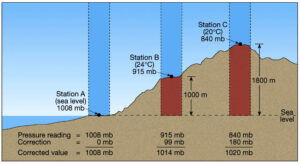
What is Atmospheric Pressure
Atmospheric pressure is the force per unit area exerted on a surface by the weight of air above that surface in the atmosphere of Earth

Atmospheric pressure is the force per unit area exerted on a surface by the weight of air above that surface in the atmosphere of Earth
Low Pressure System An area of a relative pressure minimum that has converging winds and rotates in the same direction as the earth. This is
Sunspots are regions on the solar surface that appear dark because they are cooler than the surrounding photosphere, typically by about 1500 K (thus, they
Magnetic Poles Either of the two points on the earth’s surface where the magnetic meridians converge. They are not aligned with the geographical poles, but
Maximum The greatest value attained by a function, for example, temperature, pressure, or wind speed. The opposite of minimum. Temperature The measure of molecular motion
Mean Sea Level The average height of the sea surface water level. For the United States, it is computed by averaging the levels of all
Global Weather Oscillations Inc. (GWO), a leading hurricane and climate prediction company with the best predictions record in the last 5 Years and the only
Mean Temperature The average of temperature readings taken over a specified amount of time. Often the average of the maximum and minimum temperatures. Temperature The
Air Masses An air mass is a large body of air that has relatively uniform temperature and humidity. The regions where air masses form are
Mesocyclone A area of rotation of storm size that may often be found on the southwest part of a supercell. Its circulation can be larger
10% off Accordion or Rolling Shutters 10% off Interior Rolling Shades or Exterior Motorized Screening! **MUST REQUEST DISCOUNTS AT THE TIME OF ESTIMATE**. Valid now Through Febuary 29th 2020